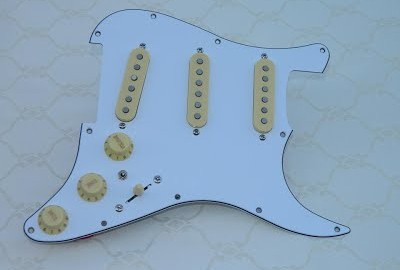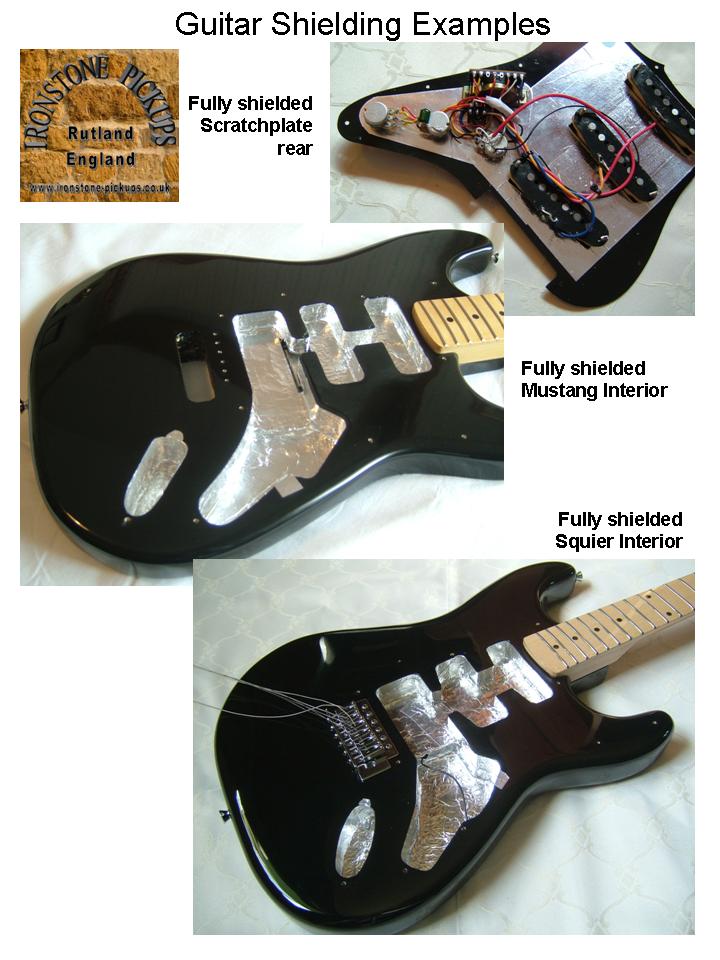Jazz Bass Dummy Coil Hum Cancelling :
Since Ironstone Pickups began selling Jazz Bass pickups in 2015, its become clear that, just like with their 6 string counter-parts, Jazz Bass players love the warmth and openness of tone that comes from the Jazz Bass single coil pickup design. But as any single coil, they are also susceptible to the unwanted electrical noise that the pickup interprets as signal. Sadly us humans detect that as noise not signal!
So assuming you want to keep your Jazz Bass tone and not opt for the Precision Bass humbucker pickup tone what can you do?
Types of electrical noise.
In an earlier Blog, I covered the types of electrical noise single coils are susceptible to. Check out the Blog;
Single Coil Pickup Dummy Coil
In that Blog I divide guitar noise into 2 basic elements, low frequency hum and higher frequency buzz (pretty commonly used terms). The most effective 'answer' to buzz is shielding.
See my Support page on the topic. Its aimed at 6 strings, but the principles are the same.
Electric guitar shielding
Hum is linked to magnetic fields created by mains power circuitry, so dominated by the frequency of the mains electrical system (50Hz here in the UK for example). Shielding will not remove hum, for that you need noise cancelling technology, and that's where dummy coils come in.
In the previous dummy coil Blog I covered the basics of pickup design and how a dummy coil can help. Also check out;
Electric Guitar Pickups Explained
So coming back to noise cancelling, this simply means adding an electrical signal containing unwanted noise to another signal containing the 'negative' or 'inverse' of that same noise. This cancelling (or 'bucking') of the hum is the principle of the humbucker design. So the humbucker (as found in a Precision Bass) is a very elegant hum cancelling solution, but the tonal characteristic is of course very different to that of a single coil.
Enter the Jazz Bass dummy coil.
So if you want your Jazz Bass pickups to keeps their tonal characteristic, where next? Well that is where the dummy coil approach comes in. Basically, a dummy coil can simply be a single coil without a magnetic component. The key requirement is that the dummy coil has its windings and / or its physical up / down orientation arranged to be in opposition to the live coil(s).
A dummy coil of around 80% of the live coils resistance value gives an excellent noise cancellation whilst leaving some 'life' in the signal which is so critical to single coil tone.
Now the tricky bit to installing a Jazz Bass dummy coil is that unlike (say) a Stratocaster, standardly configured jazz Bass guitars use a volume blend system not a distinct switch. This is further complicated by the fact the 2 Jazz Bass pickups will typically be RWRP (Reverse Wound Reverse Polarity) to each other. Since dummy coils have to be wound / connected in the reverse sense to the 'active' coil, the implication is that 2 dummy coils are needed. A standard Jazz Bass wiring schematic is shown below.

So my design goals evolved as the following;
1) Optimise the design to use just one dummy coil
2) Make the design easily compatible with standard 2 volume control, RWRP pickup Jazz Bass wiring
3) allow the players favourite 'both pickups at full volume' position to remain
4) provide hum cancelling for both bridge and neck pickups across their full volume control range.
It took a bit of experimentation, but it is possible to achieve all of the above with a simple dummy coil installation.
The dummy coil is based on a Stratocaster pickup and with the simple use of some double sided tape can be mounted on the base of the standard Jazz Bass control plate potentiometers.


How does the Jazz Bass Dummy Coil sound?
As with any dummy coil installation, the Jazz Bass dummy coil set-up gives a reduction in overall output volume (approx. 10-15%). This is not surprising as the dummy coil is effectively subtracting from the live coils signal. More importantly, a huge proportion of the background hum will have gone, for both the bridge or neck selected at any volume individually.
The usual comment about dummy coils used on 6 string guitars is that the resulting tone has a drop in treble. It's a subjective view of course, and the associated drop in volume can add to that impression.
Clear with the different frequency and harmonic register of a Bass guitar, any impact on treble is significantly less audiable.
Once the volume is equalised out, you realise that there is really little tonal difference with the dummy engaged, except of course the welcome reduction in background hum. Check out the following sound clip to see.
This sound clips give a sense of the hum reduction based on a test guitar where the dummy coil is able to be switched in and out. The recordings were made with the test guitar laying flat, giving the highest level of background mains hum (try this yourself!).
It starts with the dummy coil off and a note played. After the note has faded, at 14 secs the coil is switched on giving the significant reduction in background hum. At approximately 25 seconds, the coil is switched off giving the jump in background hum.



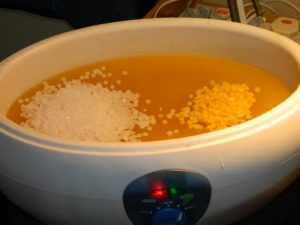


 After the timed immersion period, each pickup is withdrawn and a hot air gun used to blow off excess liquid wax. The pickups are then set to rest for a while on absorbent paper before the next manual steps.
After the timed immersion period, each pickup is withdrawn and a hot air gun used to blow off excess liquid wax. The pickups are then set to rest for a while on absorbent paper before the next manual steps.



 We find the connection of the hair thin windings to the bobbin eyelets is the most delicate part of a completed pickup. So 2 or 3 pellets of the same wax that was used in the bath is carefully melted with a small soldering iron tip over the 2 eyelet joints. Once dry, this small wax coating prevents accidental handing damage, but remains soft enough to allow for mechanical movement and temperature changes.
We find the connection of the hair thin windings to the bobbin eyelets is the most delicate part of a completed pickup. So 2 or 3 pellets of the same wax that was used in the bath is carefully melted with a small soldering iron tip over the 2 eyelet joints. Once dry, this small wax coating prevents accidental handing damage, but remains soft enough to allow for mechanical movement and temperature changes.






 Basic checks all the way through the process are at the heart of Ironstone quality control. The pole pieces are supplied as a 'default' pattern used on some other Ironstone Strat styles. So, the first job is checking all of the pole piece orientations.
That means checking the middle pickup is reverse magnetic polarity to the other two. Then the individual poles are checked for correct mounting, i.e. all 6 in a pickup are the same way round.
These checks are done simply by the law of 'opposites attract' with other magnets.
Basic checks all the way through the process are at the heart of Ironstone quality control. The pole pieces are supplied as a 'default' pattern used on some other Ironstone Strat styles. So, the first job is checking all of the pole piece orientations.
That means checking the middle pickup is reverse magnetic polarity to the other two. Then the individual poles are checked for correct mounting, i.e. all 6 in a pickup are the same way round.
These checks are done simply by the law of 'opposites attract' with other magnets.


 The poles are then individually reset by hand to the custom Hybrid pattern. Its the relative height of the poles that matters rather than the absolute height above the pickup. The measurements for the Hybrids are set against reference pickup covers, measured in mm;
E (bass) 1mm
A 1.5mm
D 2.0mm
G 1.5mm
B 1.0mm
E (treble) 1.25mm
The poles are then individually reset by hand to the custom Hybrid pattern. Its the relative height of the poles that matters rather than the absolute height above the pickup. The measurements for the Hybrids are set against reference pickup covers, measured in mm;
E (bass) 1mm
A 1.5mm
D 2.0mm
G 1.5mm
B 1.0mm
E (treble) 1.25mm
 Even though the pole pieces are free to move in the bobbins, they still have a small contact area with the windings. So once all 6 poles in a pickup have been re-positioned, its time for another quick electrical continuity check. With care, very few problems occur, but its probably not a good thing for a DIYer to try with their favourite pickup.
Resin bobbins are sometimes criticised for being a sonically inferior alternative to 'conventional' fibre flatwork construction. That is a debatable effect.
A factor that is rarely mentioned though, is that a bigger influence on tone is the winding coils cross-section. Simply, a taller thinner coil section generates a brighter tone. A squatter wide coil gives a fatter tone with more mid-range.
Any given length (resistance) of winding wire has a longer path round the bulkier inner part of a resin bobbin. That tends to give a thinner coil with greater tonal clarity and sweet treble.
Even though the pole pieces are free to move in the bobbins, they still have a small contact area with the windings. So once all 6 poles in a pickup have been re-positioned, its time for another quick electrical continuity check. With care, very few problems occur, but its probably not a good thing for a DIYer to try with their favourite pickup.
Resin bobbins are sometimes criticised for being a sonically inferior alternative to 'conventional' fibre flatwork construction. That is a debatable effect.
A factor that is rarely mentioned though, is that a bigger influence on tone is the winding coils cross-section. Simply, a taller thinner coil section generates a brighter tone. A squatter wide coil gives a fatter tone with more mid-range.
Any given length (resistance) of winding wire has a longer path round the bulkier inner part of a resin bobbin. That tends to give a thinner coil with greater tonal clarity and sweet treble.
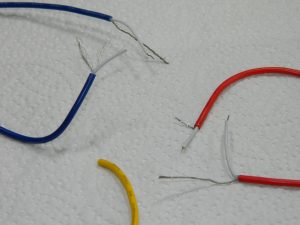



 So to assess a ceramic bars field strength, the photo below shows one placed at the 10cm point of a ruler and the detector moved up to the first point it detects and illuminates, approximately 30mm away.
So to assess a ceramic bars field strength, the photo below shows one placed at the 10cm point of a ruler and the detector moved up to the first point it detects and illuminates, approximately 30mm away.
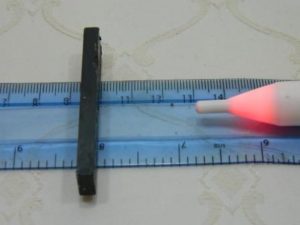 Doing the same test with a single Alnico (V) pole piece gives a detection distance of approximately 8mm. This is a much smaller mass of magnetic material of course.
Doing the same test with a single Alnico (V) pole piece gives a detection distance of approximately 8mm. This is a much smaller mass of magnetic material of course.

 Because ceramic bar magnets have their large faces as poles, its easy to simply place one onto the bottom of the basic Alnico pickup. The magnet will soon let you know if you are trying to put it on with the incorrect polarity!
Running the same field detection test gives a much stronger combined field output from the pickup magnetic 'system', close to 35mm. Wow! And bare in mind a magnets field strength is inversely proportional to distance squared. Or simply put, double the distance and the field strength goes down to one quarter of the original value.
Because ceramic bar magnets have their large faces as poles, its easy to simply place one onto the bottom of the basic Alnico pickup. The magnet will soon let you know if you are trying to put it on with the incorrect polarity!
Running the same field detection test gives a much stronger combined field output from the pickup magnetic 'system', close to 35mm. Wow! And bare in mind a magnets field strength is inversely proportional to distance squared. Or simply put, double the distance and the field strength goes down to one quarter of the original value.
 So clearly, this modified 'combination' pickup is going to be more sensitive to string vibrations than either style of pickup magnets on their own.
This is real easy home experimentation for you to try yourself too. Ceramic pickups are available cheaply - you may even have some duds laying in the spares box. As I mentioned before, ceramics are brittle so well glued examples may break as you try to prise them off the donor pup. Patience, patience.
So clearly, this modified 'combination' pickup is going to be more sensitive to string vibrations than either style of pickup magnets on their own.
This is real easy home experimentation for you to try yourself too. Ceramic pickups are available cheaply - you may even have some duds laying in the spares box. As I mentioned before, ceramics are brittle so well glued examples may break as you try to prise them off the donor pup. Patience, patience.









